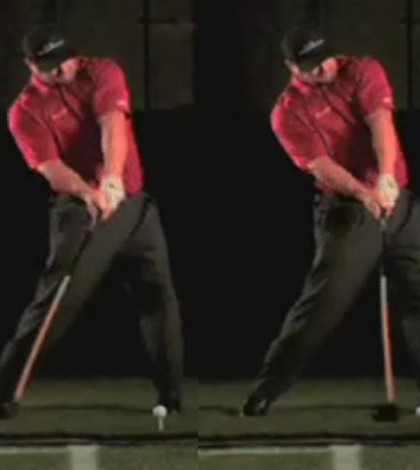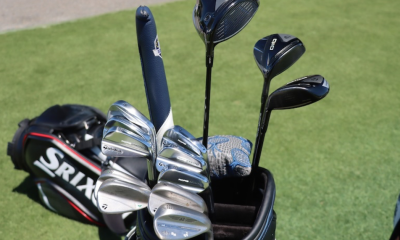Instruction
Clark: “Most golfers cannot release the club too soon”

Golfers hear a lot about release, but I honestly believe that most people do not have a good understanding of what it actually means. Here’s a working working definition of the release as I teach it:
The unhinging of the wrists and the rotation of the forearms in the downswing.
Here’s why: At some point during the swing the wrists cock and the forearms rotate away from the ball. Well, it stands to reason that during the downswing you have to unhinge the wrists and reverse the rotation of the forearms. When and how this is done is a matter of individual style and preference, but it MUST be done. More closely, if you look at the left arm and golf club as you stand at address it is more or less a straight line; but at the top of the swing that 180 degree angle changes to, in many cases, 90 degrees. You cannot get to the bottom of the golf ball unless the 180 degree straight line relationship is returned (generally speaking). Next, if you look at the club face at address it should be square to the target; but at the top of the swing, it is rotated 90 degrees OPEN to the target. For the most part, you cannot hit the golf ball squarely unless the face of the club is returned to a square position.
How and when to do this depends on several factors in your swing. So when exactly do you unhinge the wrists?
- Swing path: In-to-out swings have to release the club a little later and out-to-in swings have to release the club a little sooner. Why? Because in-to-out swings get to the bottom of the arc earlier than outside in. I always chuckle when I hear “I come over it and I cast.” My response is, “you better!”
- Swing plane: Flatter swings typically have to release the club later and upright swings have to release the club a little sooner. Why? Because flatter, wider arcs (into the ball) bottom out sooner than upright swings.
- Pivot: The more centered your pivots (less movement off the ball), the earlier you have to release the club. Players with bigger moves off the ball in the backswing release the club a little later. Why? Because the centered pivot narrowns the swing arc and moves the bottom more forward; and the move to the right (for right-handed golfers) in the backswing moves the bottom further back.
Every one of us has to unhinge the wrists and rotate the forearms back into the ball. But the sequence of this is a matter of your swing style preference. But the “line up” of the left arm and golf club and the squaring of the face is not a preference, it is a principle of impact. Also the claim that “holding the angle” or ‘lagging” the club creates distance is simply not supported by any scientific evidence. Jason Zuback is one of the longest hitters of a golf ball ever and his release point is much earlier than than Sergio Garcia’s. Jamie Sadlowski has a very late release but not as much for power as it fits his swing style, which has considerable late, increased axis tilt (upper body tilted back) in his downswing. Creating an angle and narrowing the swing arc may be essential for making a descending blow at the right place, but it does not, in and of itself, create speed.
So take a good look at your misses: late skulls, tops, big slices? Think of a an earlier release. Big hooks, fats” Think of delaying it a bit, or think about getting the body through earlier on the downswing. It is my considered opinion that most golfers cannot release the club too soon as long as they are moving to the left side, and the handle of the club does not stall coming down. I make this claim after 35,000 up-close-and-personal observations called “golf lessons.” And those of you who are regular followers of my teaching know that I teach EVERONE individually. I do not promote an early or a late release; just the right release FOR YOU.
As always, feel free to send a swing video to my Facebook page and I will do my best to give you my feedback.
Click here for more discussion in the “Instruction & Academy” forum.
- LIKE83
- LEGIT10
- WOW3
- LOL4
- IDHT3
- FLOP1
- OB2
- SHANK9
Instruction
Clement: Laid-off or perfect fade? Across-the-line or perfect draw?

Some call the image on the left laid off, but if you are hitting a fade, this could be a perfect backswing for it! Same for across the line for a draw! Stop racking your brain with perceived mistakes and simply match backswing to shot shape!
- LIKE0
- LEGIT0
- WOW0
- LOL0
- IDHT0
- FLOP0
- OB0
- SHANK0
Instruction
The Wedge Guy: The easiest-to-learn golf basic

My golf learning began with this simple fact – if you don’t have a fundamentally sound hold on the golf club, it is practically impossible for your body to execute a fundamentally sound golf swing. I’m still a big believer that the golf swing is much easier to execute if you begin with the proper hold on the club.
As you might imagine, I come into contact with hundreds of golfers of all skill levels. And it is very rare to see a good player with a bad hold on the golf club. There are some exceptions, for sure, but they are very few and very far between, and they typically have beat so many balls with their poor grip that they’ve found a way to work around it.
The reality of biophysics is that the body moves only in certain ways – and the particulars of the way you hold the golf club can totally prevent a sound swing motion that allows the club to release properly through the impact zone. The wonderful thing is that anyone can learn how to put a fundamentally sound hold on the golf club, and you can practice it anywhere your hands are not otherwise engaged, like watching TV or just sitting and relaxing.
Whether you prefer an overlap, interlock or full-finger (not baseball!) grip on the club, the same fundamentals apply. Here are the major grip faults I see most often, in the order of the frequency:
Mis-aligned hands
By this I mean that the palms of the two hands are not parallel to each other. Too many golfers have a weak left hand and strong right, or vice versa. The easiest way to learn how to hold the club with your palms aligned properly is to grip a plain wooden ruler or yardstick. It forces the hands to align properly and shows you how that feels. If you grip and re-grip a yardstick several times, then grip a club, you’ll see that the learning curve is almost immediate.
The position of the grip in the upper/left hand
I also observe many golfers who have the butt of the grip too far into the heel pad of the upper hand (the left hand for right-handed players). It’s amazing how much easier it is to release the club through the ball if even 1/4-1/2″ of the butt is beyond the left heel pad. Try this yourself to see what I mean. Swing the club freely with just your left hand and notice the difference in its release from when you hold it at the end of the grip, versus gripping down even a half inch.
To help you really understand how this works, go to the range and hit shots with your five-iron gripped down a full inch to make the club the same length as your seven-iron. You will probably see an amazing shot shape difference, and likely not see as much distance loss as you would expect.
Too much lower (right) hand on the club
It seems like almost all golfers of 8-10 handicap or higher have the club too far into the palm of the lower hand, because that feels “good” if you are trying to control the path of the clubhead to the ball. But the golf swing is not an effort to hit at the ball – it is a swing of the club. The proper hold on the club has the grip underneath the pad at the base of the fingers. This will likely feel “weak” to you — like you cannot control the club like that. EXACTLY. You should not be trying to control the club with your lower/master hand.
Gripping too tightly
Nearly all golfers hold the club too tightly, which tenses up the forearms and prevents a proper release of the club through impact. In order for the club to move back and through properly, you must feel that the club is controlled by the last three fingers of the upper hand, and the middle two fingers of the lower hand. If you engage your thumbs and forefingers in “holding” the club, the result will almost always be a grip that is too tight. Try this for yourself. Hold the club in your upper hand only, and squeeze firmly with just the last three fingers, with the forefinger and thumb off the club entirely. You have good control, but your forearms are not tense. Then begin to squeeze down with your thumb and forefinger and observe the tensing of the entire forearm. This is the way we are made, so the key to preventing tenseness in the arms is to hold the club very lightly with the “pinchers” — the thumbs and forefingers.
So, those are what I believe are the four fundamentals of a good grip. Anyone can learn them in their home or office very quickly. There is no easier way to improve your ball striking consistency and add distance than giving more attention to the way you hold the golf club.
More from the Wedge Guy
- The Wedge Guy: Golf mastery begins with your wedge game
- The Wedge Guy: Why golf is 20 times harder than brain surgery
- The Wedge Guy: Musings on the golf ball rollback
- LIKE86
- LEGIT13
- WOW6
- LOL1
- IDHT0
- FLOP4
- OB1
- SHANK8
Instruction
Clement: Stop ripping off your swing with this drill!

Not the dreaded headcover under the armpit drill! As if your body is defective and can’t function by itself! Have you seen how incredible the human machine is with all the incredible feats of agility all kinds of athletes are accomplishing? You think your body is so defective (the good Lord is laughing his head off at you) that it needs a headcover tucked under the armpit so you can swing like T-Rex?
- LIKE0
- LEGIT2
- WOW2
- LOL0
- IDHT0
- FLOP0
- OB0
- SHANK2
-

 19th Hole2 weeks ago
19th Hole2 weeks agoDave Portnoy places monstrous outright bet for the 2024 Masters
-

 19th Hole3 days ago
19th Hole3 days agoJustin Thomas on the equipment choice of Scottie Scheffler that he thinks is ‘weird’
-

 19th Hole2 weeks ago
19th Hole2 weeks agoTiger Woods arrives at 2024 Masters equipped with a putter that may surprise you
-

 19th Hole2 days ago
19th Hole2 days ago‘Absolutely crazy’ – Major champ lays into Patrick Cantlay over his decision on final hole of RBC Heritage
-

 19th Hole3 weeks ago
19th Hole3 weeks agoReport: Tiger Woods has ‘eliminated sex’ in preparation for the 2024 Masters
-

 19th Hole1 week ago
19th Hole1 week agoTwo star names reportedly blanked Jon Rahm all week at the Masters
-

 19th Hole1 week ago
19th Hole1 week agoReport: LIV Golf identifies latest star name they hope to sign to breakaway tour
-

 19th Hole1 week ago
19th Hole1 week agoNeal Shipley presser ends in awkward fashion after reporter claims Tiger handed him note on 8th fairway















Greg V
Dec 30, 2014 at 10:30 am
Jack Nicklaus once stated that it was impossible to release the club too early if his legs were working correctly.
Harry Vardon believed that he was throwing the clubhead back through the ball with his right thumb and forefinger.
Those two guys were pretty good at hitting a golf ball. That would be 9 Open Championships and 5 US Opens among them.
mark
Dec 2, 2014 at 2:17 am
Didn’t Mike Austin say that back in about 1950?
Todd
Sep 11, 2014 at 7:52 pm
You can rotate the clubface around the sweetspot without bending the wrists. And you can bend the wrists without rotating the clubface. So, lining up the shaft with the left arm is not a requirement to square the clubface at impact. Almost all pros exhibit a shaft which is behind the left arm at impact. Besides all this, if the attack angle is less than optimally descending, then the release has occurred too early.
J. Evans
Jun 25, 2014 at 10:12 am
Hello Dennis,
For any given golfer, is the release point the same for all clubs (full shots only, not specialty shots) wedge to driver, OR, is there a different release point for full wedges, vs, irons, vs hybrids, vs woods, thanks.
Dave
Jul 21, 2013 at 12:49 pm
Like this but it doesn’t tell you HOW to release the club.
Scott
Apr 25, 2013 at 4:46 pm
This has changed my golf game. Fantastic article
Caleb Hoshiyama
Feb 5, 2013 at 5:12 pm
How do you measure Spin Loft? I know Trackman measures angle of attack; so if my angle of attack on my driver is 4 degrees (I think ideal?) and my driver is a 9 degree (true measurement, not stamped), my SL would be 5 degrees? I am missing something here?
Alex
Dec 13, 2014 at 1:58 am
SL is the difference between dynamic loft and AoA. Not your club head’s measured loft.
You need to know what your dynamic loft is in order to calculate spin loft.
jesse
Dec 20, 2012 at 1:01 am
Dennis, your Oct. 24th @ 4:10PM answer was somewhat revealing, but you were very unclear in mentioning the D Plane & the “lower the SL”, dynamic loft (lower the SL). This is very unclear and confusing. Just exactly what are you trying to arrive at when you talk about the “dynamic loft”. I guess you could say the golf swing is dynamic, but what does that have to do with ball flight? Too many moving parts here.
Dennis Clark
Dec 26, 2012 at 6:41 pm
Dynamic loft is the actual impact loft as opposed to the manufacturer loft. SL is SPIN LOFT and when it is lower, the golf is MORE compressed )SL is dyamic loft MINUS attack angle) My top guys get their driver spin loft down to 10-11 degrees, which is REALLY solid. It’s a measure of compression. Thx. DC
ryebread
Nov 8, 2012 at 1:13 pm
I like the article and tend to agree. The question that I don’t see answered is the release point trigger — particularly for those fighting the dreaded slice.
Dustin
Nov 8, 2012 at 11:06 am
Dennis,
Can’t agree more. Tons of good info coming out of Michael Jacobs/Brian Manzella etc. regarding the release. For so long most of us including myself have tried to emulate the “lag” look and trying to delay the release when in effect, actually sends the clubhead out REDUCING lag. Trying to line that club up as soon as possible is more powerful, and easier to square the club. Trying to take the lag out, actually visually makes it look like there is more lag! Great article, and keep up the good work coming out of science not pictures and video!
joe
Oct 31, 2012 at 11:40 pm
Also dennis, while your article is written in simple terms, i think it is beyond the comprehension of those not “in the know” about the golf swing.
Blanco
Nov 7, 2012 at 3:14 am
I disagree. The fact that he defines release in the beginning of the piece makes this more concise and understandable than most articles. The article is about release, not swing plane; I find it’s easy to get off-topic in an instructional article… where he could have gone into explanation about swing plane and shot shape (open face/in-to-out=draw, etc.), he chose to keep this simple. When learning golf my biggest knock on teachers is that they fail to achieve understanding of key concepts before expanding on them. Great article.
joe
Oct 31, 2012 at 11:34 pm
Ok dennis, you won me over with this article. Is it possible to hit a fade with an in to out swing? I cannot hit a fade for the life of me with my release. Hitting right to left and around trees right to left is a breeze. 1 in 20 shots i can hit a fade but it is obviously not consistent in fading. If i have to hit a dogleg or around a tree left to right, im in trouble.
Nathan W
Jan 9, 2013 at 2:49 pm
I use to play an outside to drop inside swing. You can hit a fade from it, but it can be difficult. I use to drop my head shoulders and everything to prevent being out front. I would then hold my hands off to hit a push fade. I wouldn’t suggest this way by any means. I couldn’t suggest a way to hit a fade w/o truely seeing your swing.
Greg V
Dec 30, 2014 at 10:36 am
To hit a fade, try aiming to the left, then holding off your release a bit while you rotate hard to your left.
It really helps if you keep your right side “high” through the shot.
You still hit from the inside, but because your target line shifts to the left, and you hold off your release, your actual path to your intended target will be left of the intended target with an open face.
Also, it is very important that your “eye line” is left of your intended target line.
christian
Jan 5, 2015 at 11:21 pm
If hitting driver from the tee-box, just tee the ball really low. This almost automatically gives me a fade.
dennis
Oct 24, 2012 at 4:10 pm
Thx for reply; If you read Paul Wood, Steven Nesbitt, Muira et al, the scientists (physicists, biomechanists etc) who reseach this for a living, my report is based on THEIR findings, It is not an assumption that I related based on lack of detail. When I am in search of knowlegede in a field outside mine, I rely on what the SCIENTIFIC community has to say on the subject, I find it more reliable than internet blogs. That is why I invested in a Trackman so I could do golf pro level experiments on human case studies, i.e. my students over time. And the laggers or handle tuggers have no advantage over the early releasers from the turf or the tee. As for the path, it has very little control on the initial direction of the golf, 25% at the most, so your path observations concerning pull and push would only be the case if the the face (75% of the initial direction) is looking in that direction. And spin loft is the D PLane (the difference in the attack angle and dynamic loft) the lowerthe SL the greater the compression. What you missed is the basic point of the article. That MOST golfers commit their bodies (upper body opening early) before they ever lower their arms or release their club. Again just an empirical observation over many years Thx for the interest. DC
Cliff
Oct 23, 2012 at 4:30 pm
Dennis,
You say that an in to out swing path must release later. If I come from the inside and I release on time wouldn’t I push it in the exact direction that my swing path dictates or even further right if I’m late? On the other hand if I come from the outside of the ball and I release normal I hit a straight pull, if I release earlier I hit a hook.
Your point about how late release does not mean more distance is interesting. Sergio Garcia is not know to be the worlds longest driver, he is known to be pretty long with his irons, specifically long irons. A late release that ends up square may have the same clubhead speed through impact as one with an early release but the spin rate is not the same, and no, it’s not about steepness. The reason a late release person can hit irons so long is because their ball comes out with more spin. Faster acceleration over a shorter distance where you reach the same ultimate speed mean more time spent touching the ball and a greater amount of friction produced on the urethane cover.
I don’t think your article is bad, in fact it’s quite interesting for most people that don’t care about the granular details of physics. I do think that you have a mistake in your thinking and cannot make an assumption based on a single dimension when the problem involves several dimensions that you haven’t examined in as much detail.
Ryan
Oct 20, 2012 at 2:54 pm
The last two articles by Dennis Clark are the most important things that I have learned from Dennis. I have been playing golf for about 20 years. About 10 years ago I started working with Dennis. My main lesson was “Turn and Release”. It was this concept that helped me get to scratch in just about 2 years. Also helped me gain about 25-35 yards off my driver. He drilled this concept into me every lesson I had. Larger Turn and Earlier Release; helped square the face and increase my club head speed. “Turn and Release” made me “Longer and Straighter”. Thanks a Million Dennis